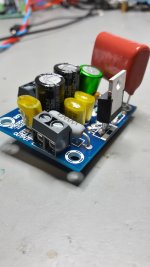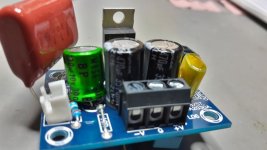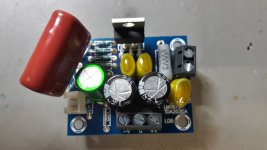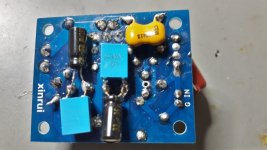What i do not expect is that if i switch from square to sine wave i normally get a destroyed ringing at the top of the upper sine wave above 400-500mVrms - this is why i get the hint to use the reeistor between pin 1 -2 (2k7 or 5k)
look at post #347 or #320
now with 440nF at the output it gone.
examples:
pic 1 shows 550mVrms with 440nF at the output
pic 2 the same power without the 440nF at the output
pic 3 shows 600mVrms with 440nF at the output
pic 4 the same power without the 440nF at the output
pic 5at my input 620mVrms
??? why does the 440nF healed here???
chris
Hi Chris,
In general your square-wave response looks fine. Will there be a short listening test before you abandon the Amazon LM1875? My interest in this is that it may indicate to "newbies" if there is any point in experimenting with such very cheap LM1875 boards.
When you test an amplifier with a square-wave input, the "ringing" you see in the response is caused by the known intentional regulation loop. That ringing we know how to influence.
The self-oscillation you see at the top of the sine-wave is of a much higher frequency and likely not caused by the intentional loop. It is likely to be a phenomena generated in the driver/output stage of the LM1875. That means that the self-oscillation is not mastered the same way as we master the intentional control loop. Apparently the 440nF loading manage to kill the self-oscillation when the amplifier gain is reduced by the resistor.
Last edited:
Hi FF
yes i did a listening test to the other amp (amp1 - green muse-smaller cap bank..). the sound by the amp 2 is very good. its very similar to the other amp. post 332.
it doesn´t matter if I correct it with the resistor at pin1 ,2 or before - its sound the same. maybe the listening level was/is to low to hear any effect.
generally i want to close this topic with the original kit with some modifications.
its still a fine/cheap amp. remember i use mostly all components of the kit:
recovered chip, resistors, caps (100nF, 330p..) - execpt the input caps , FB cap, or at the amp 2 the bigger 1000µF/50V caps- the amp with the green muse ues caps is using the original 100µFcaps x2 each rail (under pcb)
next step: the kit with the best parts ---- > so i really expect a step forward in SQ
chris
yes i did a listening test to the other amp (amp1 - green muse-smaller cap bank..). the sound by the amp 2 is very good. its very similar to the other amp. post 332.
it doesn´t matter if I correct it with the resistor at pin1 ,2 or before - its sound the same. maybe the listening level was/is to low to hear any effect.
generally i want to close this topic with the original kit with some modifications.
its still a fine/cheap amp. remember i use mostly all components of the kit:
recovered chip, resistors, caps (100nF, 330p..) - execpt the input caps , FB cap, or at the amp 2 the bigger 1000µF/50V caps- the amp with the green muse ues caps is using the original 100µFcaps x2 each rail (under pcb)
next step: the kit with the best parts ---- > so i really expect a step forward in SQ
chris
Last edited:
Just a quick post to say I'm tagging along here (first diyaudio post actually). You guys made some very informative posts, I read through the whole thread last night.
I have some of those boards on order, I'd be really interested in having a run down of the "optimal" BOM once you are satisfied with this kit.
Cheers,
I have some of those boards on order, I'd be really interested in having a run down of the "optimal" BOM once you are satisfied with this kit.
Cheers,
Just a quick post to say I'm tagging along here (first diyaudio post actually). You guys made some very informative posts, I read through the whole thread last night.
I have some of those boards on order, I'd be really interested in having a run down of the "optimal" BOM once you are satisfied with this kit.
Cheers,
hi cok666n
fine that you enjoy it. its good to have some specialists here - like rabbitz, Bare, FF...
the original kit is really good- just change the input cap and make the feedback cap better (bipolar 100µF)- spend a hugh cap bank after the rectifier and you get a very fine amp. the other things are "healing" some issues 😉
chris
I have some of those boards on order, I'd be really interested in having a run down of the "optimal" BOM once you are satisfied with this kit.
Cheers,
Here's a list of components that I used in this amplifier. As has been suggested several times in this thread, dump the parts supplied with the kit and use genuine components.
The amplifier as per the schematic works fine and gives a good sound but that doesn't stop any tweaking possibilities.
Suggested value, type [D=dia max mm][P=lead spacing mm] brand
Resistors: 0.5W metal film [10P]
Input cap: 10uF electrolytic BP 35-50V [9D][2.5-10P] Nichicon ES
Alt input cap: 1-2.2uF 63V-100V MKT, MKP, MMK [2.5-10P] Vishay, Kemet
330pF: Ceramic C0G 50V [5P] TDK, Murata (also tried 220pF and without... no difference AFAICT)
100nF: Ceramic X7R 50V [5P] TDK
220uF: Electrolytic 35-50V [10D][3.75-5P] Panasonic FC, Nichicon KA, Nichicon FW (tried as low as 82uF which works)
47uF: Electrolytic BP 16V [6D][2.5-5P] Nichicon ES (I could only fit 22uF but did try a 47uF Nichicon FG)
Zobel resistor 1R: 1-2W metal film [15P] Panasonic ERX (also tried 2R7 as per ESP and Chipamp.com)
Zobel 220nF: 63V [5P] Vishay, Kemet (also tried 100nF as per ESP and Chipamp.com with above)
It is also suggested to match resistors and caps for each module especially the 1K and 22K in the feedback loop from pin 4.
For the power supply I used 50VA (1)/ 120VA (2) 18-0-18AC, 35A bridge rectifier, Nichicon LS 2x4700uF (1) / 2x10000uF (2) caps.
Thanks Rabbitz, that's exactly what I was looking for.
I'll order the parts once I have the boards on hand and have a better understanding of which part is which. I'll make sure to report back.
I've been quite rusty with electronics (EE background but I've been coding for over a decade), so I might ask stupid questions along the way.
Out of curiosity, do you guys like that amp sound? Do you actually use them?
I saw a lot of LM3886 boards on ebay, the small ones from XY Hifi, but they seem to miss a lot of things to function properly (ie: no zobel, filtering, etc). So I figured the LM1875 was a simpler kit to start me back with electronics, would the LM3886 be more rewarding sound-wise?
I'll order the parts once I have the boards on hand and have a better understanding of which part is which. I'll make sure to report back.
I've been quite rusty with electronics (EE background but I've been coding for over a decade), so I might ask stupid questions along the way.
Out of curiosity, do you guys like that amp sound? Do you actually use them?
I saw a lot of LM3886 boards on ebay, the small ones from XY Hifi, but they seem to miss a lot of things to function properly (ie: no zobel, filtering, etc). So I figured the LM1875 was a simpler kit to start me back with electronics, would the LM3886 be more rewarding sound-wise?
Hi
BOM as requested
source this threads: Yet another LM1875 amp - review request
LM1875 - Best Components and values
i decided to use this: (some parts are for a psu)
338-1108-ND MC12FA101J-F CAP MICA 100PF 5% 100V
1210 490-7751-1-ND GRM0335C1H101GA01D CAP CER 100PF 50V C0G/NP0 0201
338-2634-ND CD15FD101FO3F CAP MICA 100PF 1% 500V RADIAL
PPC3D2.2KCT-ND PAC300002201FAC000 RES 2.2K OHM 3W 1% AXIAL
493-3467-ND QYX1H104JTP CAP FILM 0.1UF 5% 50VDC RADIAL
BC1019CT-ND K331J15C0GF5TL2 CAP CER 330PF 50V C0G/NP0 RADIAL
P14629-ND ECQ-E1106JF CAP FILM 10UF 5% 100VDC RADIAL
493-3471-ND QYX1H224JTP CAP FILM 0.22UF 5% 50VDC RADIAL
S22KCACT-ND RNMF14FTC22K0 RES 22K OHM 1/4W 1% AXIAL
S1KCACT-ND RNMF14FTC1K00 RES 1K OHM 1/4W 1% AXIAL
BC4522CT-ND MBE04140C1008FC100 RES 1 OHM 1% 1W
AXIAL WW3FT1R00CT-ND WW3FT1R00 RES 1 OHM 3W 1% AXIAL
see pics
the decoupling cap i use:
470 µf/35V ZLH nichicon + 33µF panasonic + 0,47µ MKT TDK in parallel at the board - the input cap 10µF foil panasonic is really huge 😛
R2 is shorted, 100pF - yellow cap under pcb is in parallel to the 22k Fb resistor,
other terminals, LM1875 by TI shop
"burn in" is running since 1 day 😎...Sound check at the weekend
chris
BOM as requested
source this threads: Yet another LM1875 amp - review request
LM1875 - Best Components and values
i decided to use this: (some parts are for a psu)
338-1108-ND MC12FA101J-F CAP MICA 100PF 5% 100V
1210 490-7751-1-ND GRM0335C1H101GA01D CAP CER 100PF 50V C0G/NP0 0201
338-2634-ND CD15FD101FO3F CAP MICA 100PF 1% 500V RADIAL
PPC3D2.2KCT-ND PAC300002201FAC000 RES 2.2K OHM 3W 1% AXIAL
493-3467-ND QYX1H104JTP CAP FILM 0.1UF 5% 50VDC RADIAL
BC1019CT-ND K331J15C0GF5TL2 CAP CER 330PF 50V C0G/NP0 RADIAL
P14629-ND ECQ-E1106JF CAP FILM 10UF 5% 100VDC RADIAL
493-3471-ND QYX1H224JTP CAP FILM 0.22UF 5% 50VDC RADIAL
S22KCACT-ND RNMF14FTC22K0 RES 22K OHM 1/4W 1% AXIAL
S1KCACT-ND RNMF14FTC1K00 RES 1K OHM 1/4W 1% AXIAL
BC4522CT-ND MBE04140C1008FC100 RES 1 OHM 1% 1W
AXIAL WW3FT1R00CT-ND WW3FT1R00 RES 1 OHM 3W 1% AXIAL
see pics
the decoupling cap i use:
470 µf/35V ZLH nichicon + 33µF panasonic + 0,47µ MKT TDK in parallel at the board - the input cap 10µF foil panasonic is really huge 😛
R2 is shorted, 100pF - yellow cap under pcb is in parallel to the 22k Fb resistor,
other terminals, LM1875 by TI shop
"burn in" is running since 1 day 😎...Sound check at the weekend
chris
Attachments
Last edited:
Wow, nice idea on stuffing the parallel caps under the board. You're doing that to lower the noise on the supply rails right?
And thanks for the BOM, I will wait for your sound appreciation 🙂
And thanks for the BOM, I will wait for your sound appreciation 🙂
Out of curiosity, do you guys like that amp sound? Do you actually use them?
I saw a lot of LM3886 boards on ebay, the small ones from XY Hifi, but they seem to miss a lot of things to function properly (ie: no zobel, filtering, etc). So I figured the LM1875 was a simpler kit to start me back with electronics, would the LM3886 be more rewarding sound-wise?
The LM1875 in this thread is a good sounding amp that can bring a smile as long as it's not pushed too hard and used in the right application. Mine sits gathering dust along with other amps not in use but it was on a to do list. Even so, I'm going to build another but with different values based on Brian Bell's (Chipamp.com) version as I have the parts available. I will find a use eventually.
The LM3886 is a better amp sonic wise with more headroom and better dynamics. I can't comment on the eBay versions but have experience with Nuerochrome's 3886DR and Rod Elliott's ESP P19 which are both very good amps. The 3886DR is a tad smoother and the P19 is a bit more engaging but they are still very similar. I also have a Arcam FMJ A19 which is a composite LM3886 and has a great presentation, good dynamics, plenty of detail and punches well above it's specs. Kind of reminds me of my old AKSA 55N+ which is a compliment.
The LM1875 is a great little kit to get into the hobby and most have been happy with the results. A big plus is it's a single sided PCB so any errors can be corrected easily unlike double sided PCBs which are a pain to desolder components.
Last edited:
i found this board. it looks with less components for the LM1875
SUQIYA 20W Gaincard version of the two channel LM1875 power amplifier kit finished board tube flavor-in Amplifier from Consumer Electronics on AliExpress
Here is bare pcb if you are interested GC LM1875 2x20W Dual Channel Stereo Power Amplifier Board PCB Dual AC 15V~18V 699948246962 | eBay

So you dont need to buy fake parts.
Thanks nenad88
did you tried the 1875 with this board? this board is with rectifier on it.
here is a amp/
board with all inclusive + parallel LM1875
ZEROZONE One pair Assembeld Gaincard (GC) LM1875 Parallel Power amplifier board-in Amplifier from Consumer Electronics on AliExpress
pcb
SUQIYA GC parallel version LM1875 power amplifier PCB bile power amplifier PCB (set of two)-in Amplifier from Consumer Electronics on AliExpress
chris
did you tried the 1875 with this board? this board is with rectifier on it.
here is a amp/
board with all inclusive + parallel LM1875
ZEROZONE One pair Assembeld Gaincard (GC) LM1875 Parallel Power amplifier board-in Amplifier from Consumer Electronics on AliExpress
pcb
SUQIYA GC parallel version LM1875 power amplifier PCB bile power amplifier PCB (set of two)-in Amplifier from Consumer Electronics on AliExpress
chris
The LM1875 in this thread is a good sounding amp that can bring a smile as long as it's not pushed too hard and used in the right application. Mine sits gathering dust along with other amps not in use but it was on a to do list. Even so, I'm going to build another but with different values based on Brian Bell's (Chipamp.com) version as I have the parts available. I will find a use eventually.
The LM3886 is a better amp sonic wise with more headroom and better dynamics. I can't comment on the eBay versions but have experience with Nuerochrome's 3886DR and Rod Elliott's ESP P19 which are both very good amps. The 3886DR is a tad smoother and the P19 is a bit more engaging but they are still very similar. I also have a Arcam FMJ A19 which is a composite LM3886 and has a great presentation, good dynamics, plenty of detail and punches well above it's specs. Kind of reminds me of my old AKSA 55N+ which is a compliment.
The LM1875 is a great little kit to get into the hobby and most have been happy with the results. A big plus is it's a single sided PCB so any errors can be corrected easily unlike double sided PCBs which are a pain to desolder components.
Thanks Rabbitz, I might end up using Neurochrome PCBs if I want to do a more serious amplifier down the line. For now, they are a bit expensive for my tastes.
No I didnt try that board.
I have tried this and it is good, I didnt measure anything its just play good.
PCB Board For HIFI Amplifier Dual Op Amp LM1875 25W*2 17V~18V | eBay

These boards were much more expensive back then when I tried it.
I have tried this and it is good, I didnt measure anything its just play good.
PCB Board For HIFI Amplifier Dual Op Amp LM1875 25W*2 17V~18V | eBay

These boards were much more expensive back then when I tried it.
Last edited:
thx nenad88, but i keep this board ...
best parts amp:
i am impatient...😉
sound check 4 times 3 titles for comparison..
First SQ check is really very very good !😎 its sound very easy, clear, detailed, dark,.....all adjective which i had with my comparisons of the 2 amps ! - its not a sound what you can "imagine" its here - now - and very smooth.
actually i "just" use the very small cap bank - (4x2200µ + 4x1000µF)
i have to mod my psu bank and go ahead...
chris
best parts amp:
i am impatient...😉
sound check 4 times 3 titles for comparison..
First SQ check is really very very good !😎 its sound very easy, clear, detailed, dark,.....all adjective which i had with my comparisons of the 2 amps ! - its not a sound what you can "imagine" its here - now - and very smooth.
actually i "just" use the very small cap bank - (4x2200µ + 4x1000µF)
i have to mod my psu bank and go ahead...
chris
Yes, many alternative PCB's do exist.
The subject of this thread however is the monoblock PCB, which offers many advantages.
Ideal for experiments and education - as this thread has shown. Tuning of the amplifier circuit, adaptations, groundloop wiring/routing, optimizing and testing the (external) power supply.
It is all easy on the single sided pcb and separate PS.
An on-board power supply lags flexibility and on top of that the pcb-layout of the "cheap" board is highly professional.
The subject of this thread however is the monoblock PCB, which offers many advantages.
Ideal for experiments and education - as this thread has shown. Tuning of the amplifier circuit, adaptations, groundloop wiring/routing, optimizing and testing the (external) power supply.
It is all easy on the single sided pcb and separate PS.
An on-board power supply lags flexibility and on top of that the pcb-layout of the "cheap" board is highly professional.
thx nenad88, but i keep this board ...
...............
First SQ check is really very very good !😎 its sound very easy, clear, detailed, dark,.....all adjective which i had with my comparisons of the 2 amps ! - its not a sound what you can "imagine" its here - now - and very smooth.
actually i "just" use the very small cap bank - (4x2200µ + 4x1000µF)
chris
Hi Chris,
From before your main involvement in DIY, you have/had a commercial power amplifier of some kind (probably very well reputed). Is it possible for you to give a rough estimation of the SQ of this LM1875 amplifier compared to your commercial amplifier (disregarding power capacity, "features" and looks)? On par or below?
Hi FFHi Chris,
From before your main involvement in DIY, you have/had a commercial power amplifier of some kind (probably very well reputed). Is it possible for you to give a rough estimation of the SQ of this LM1875 amplifier compared to your commercial amplifier (disregarding power capacity, "features" and looks)? On par or below?
Yes i will do this. my Accuphase P300V is not working since 2017 - i had this amp 28 years - i did a restoration but it failed 🙁--> this is the reason i start to diy...to be honest🙂 i have a Arcam FJM AVR390 - its a AV receiver in bi amping mode...- sound is not really outstanding in my opinion...its long time ago i used it 😀 --->
i tried a Cambridge audio azur 851 integrated amp 2016-2017 - very good amp - but about 1400 euro ? today not acceptable for me...😉😀
but first i want to give this amp a appropriate cap bank. today i listened once again to this "best parts" amp...very very nice. i do not think that its perfect but the sound in the mid and upper frequency level is outstanding...maybe i am biased but ....i do my exercise as usual.
the only thing i saw is that at 510mVrms input - about 12Vrms output at 8R = about 18Watt - i get once again this "ringing" at the top??? with 440nF caps a the ouptu its gone..
chris
Last edited:
- Home
- Amplifiers
- Chip Amps
- eBay mono LM1875 kit



